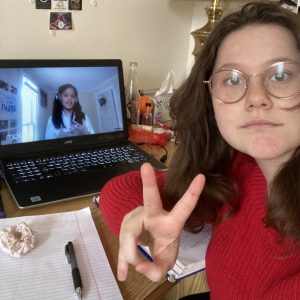
Last fall, Karen Isble joined Kalamazoo College as the institution’s vice president for advancement, bringing with her a broad background in development and extensive campaign experience. Isble came to K from the University of California, Irvine, where she served as associate vice chancellor and campaign director for university advancement, leading the planning and execution of the university’s $2 billion comprehensive campaign, “Brilliant Future.” Prior to joining UC Irvine, Isble served as assistant vice president for development at the University of Michigan. A Detroit native, Isble worked in arts administration and fundraising roles at the Chamber Music Society of Detroit, the Chicago Symphony Orchestra and the Goodman Theatre prior to joining U of M. Isble earned her bachelor’s from Harvard University and her master’s from the University of Michigan. We sat down with Isble and asked her to reflect on her time so far at K and the opportunities and challenges facing the field of advancement.
What drew you to Kalamazoo College?
The reputation of both the College and Kalamazoo’s strong philanthropic community was a huge draw, as well as proximity to my family here in Michigan and Chicago. Honestly, though, the biggest draw was the strong leadership team and sense of community—and the opportunity to focus my advancement efforts on a smaller institution that was centered on students first. So far, my early observations have not disappointed—it’s all that I could have hoped for, even having made this transition amidst the pandemic.
What excites you most about your job?
Bringing people together—alumni, community leaders, donors, faculty, staff and students—for a united cause: access to and enrichment of higher education. I also love seeing those efforts come to life on campus—students taking advantage of all that K has to offer, faculty gaining new resources, and new and updated spaces where students live, learn and play.
What are some of the challenges for university and college advancement programs today?
Like any nonprofit institution, there’s ever-increasing competition for where donors can give their philanthropy. We’re continually working to stay ahead of the curve and to make sure our stories of why donors should support higher ed are compelling, transparent and exciting. Creating a clear path along the pipeline from marketing/communications to alumni/community engagement to fundraising/stewardship takes the work of many talented people with varying skill sets, all working in concert. There are a lot of opportunities to miss a step, and all of the steps are important.
How has COVID-19 changed the way we approach alumni engagement and fundraising?
The same way it’s changed everything, really. A year ago, we were all at a bit of a standstill across the industry, and we couldn’t have imagined that the work we do could be done any other way. Traveling with the college president to alumni events, individual in-person meetings with donors, large-scale gatherings like homecoming—they’re the key tools we use to stay in front of our constituents and keep them informed about what’s happening on campus. The pandemic swept all of that aside, and it took us some time to think about how we could (and when and whether we should) try to engage with alumni and donors virtually. We had to learn what that felt like, sounded like. Fortunately, we’ve done a good job here at K—and across the field—in embracing these new forms of outreach, and, even when we’re able to travel and gather again with ease, we will keep some of these new “tools” close at hand. They’ve helped us not only stay connected with those we were already close to, but make new connections with those who had never had the opportunity to engage with K in person.
On a personal note, what are three things people may be surprised to learn about you?
- I’m only five feet tall—they tried to tell me 4’11”, but I’m not buying it.
- I pivoted from pre-med student to aspiring opera singer during college. I still sing when I can, and I can’t wait until choirs can gather again!
- I’m a sci-fi geek. Star Wars, Star Trek—I’ll take them all. I’m also a huge fan of the Harry Potter, Lord of the Rings and Marvel franchises.


















